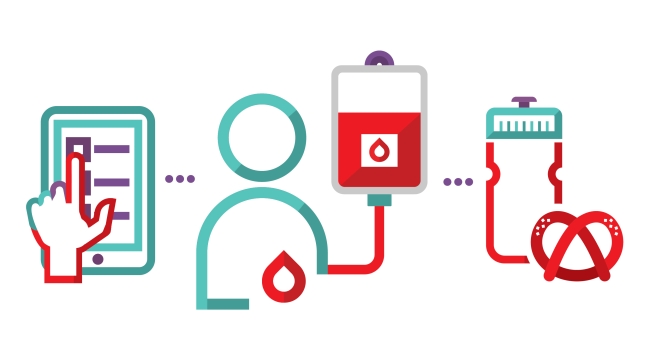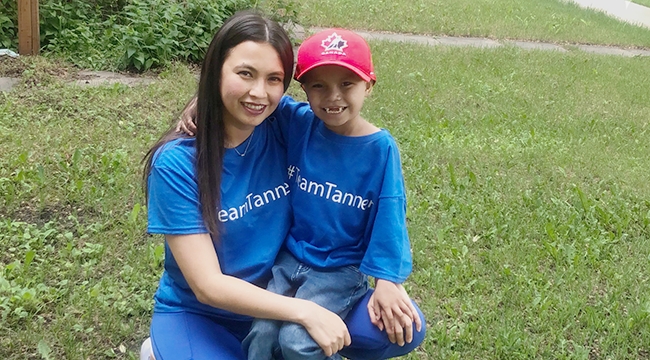Cord blood donors could be someone’s hope for life
Umbilical cord blood is rich in stem cells, which can treat more than 80 diseases including leukemia
As a child, N’kem Odita moved around the Greater Toronto Area with her mom, living in many multicultural communities. She learned very early in life that diversity was a strength.
Now, as an adult working in Canada’s health sector, N’kem sees how diversity — specifically, stem cells from diverse donors — can save lives.
The more genetically diverse someone’s background is, the more difficult it can be to find a matching stem cell donor for a transplant. Only 32 percent of potential donors on Canadian Blood Services Stem Cell Registry currently represent diverse groups.
That’s why in 2019, when N’kem and her Trinidadian husband found out she was pregnant with their son Marcus, they wanted to “pay it forward” by donating their baby’s umbilical cord blood, hoping that it would help a patient in need.
“There was no hesitation at all, I felt like I wanted to do it if it helps save someone’s life,” says N’kem, who now lives in Ottawa. “Donating cord blood is such a simple way to save a life.”
In addition to her desire to “pay it forward”, N’kem was also driven by the need for stem cells from donors of mixed ethnicity.
“It’s hard to imagine how difficult it might be for a patient who’s mixed like myself and my son to find a stem cell match if they ever needed a transplant,” says N’kem, whose mother is Afro-Canadian and Mi'kmaq while her father is African.
What is cord blood?
The blood left in the umbilical cord and placenta after a baby is born is rich with lifesaving blood stem cells. Canadian Blood Services’ Cord Blood Bank collects and stores this cord blood for future use by anyone in need of a stem cell transplant. Collection happens after the safe delivery of the baby and placenta, so it does not interfere with the process of labour or birth. But unless mothers opt to preserve cord blood for patients or for research, it is normally discarded as medical waste.
Like stem cells found in bone marrow or circulating blood, those found in cord blood can also be used to treat more than 80 blood cancers and disorders. But stem cells from cord blood have several unique advantages over those collected from bone marrow or circulating blood. They are collected in advance, stored and ready for use immediately when needed. That can mean a shorter wait time for the patient who needs a match for a transplant.
How umbilical cord blood saves lives: one recipient’s story
Why cord blood is so important during COVID-19
To significantly increase the odds of finding a matching stem cell donor for all patients, Canada’s stem cell registry belongs to an international network of registries to match potential donors and recipients around the world. Access to a global community of stem cell donors is critical, as no country is completely self-sufficient in stem cells. Currently, around 89 per cent of Canadian patients in need of a transplant receive stem cells from other countries.
International border closures and travel restrictions caused by COVID-19 have created some challenges for international donation and transplant, which means patients and transplant centres are now relying more on donors in Canada. And cord blood has proved to be a ready and accessible lifesaving resource for patients. In the first half of 2020, Canadian Blood Services’ Cord Blood Bank saw more requests and shipments for stem cells from cord blood than it had seen in the entirety of 2019.
Another reason why cord blood is an extremely valuable resource is because, unlike stem cells from bone marrow or circulating blood, stem cells from cord blood do not need to be an exact match for a patient.
Everyone has specific inherited genetic markers, and patients are more likely to find a successful match from a donor with similar ancestry. Patients of diverse or mixed-race backgrounds often face a much steeper hill when searching for a matching donor. That is why Canadian Blood Services is building a stem cell registry that reflects Canada’s unique diversity, as well as a diverse cord blood bank.
Register online to donate cord blood
Free info sessions to debunk myths around public cord blood donation
There is so much to do and so many decisions to be made when expecting a baby — and helping to save lives by registering to donate cord blood could be the easiest one. However, there are several myths around cord blood donation that require de-bunking.
That’s why Canadian Blood Services has launched a series of live, online information sessions this fall, to help answer questions from expectant mothers who are considering registering to donate their cord blood.
Cord blood frequently asked questions
“We’ve organized these live information sessions to reach as many expectant mothers, their partners and their families as we can,” says Karen Mostert, manager, cord blood recruitment and collections at Canadian Blood Services. “We want to dispel potential myths and provide them facts about cord blood donation and how this precious resource can save lives.”
These free sessions will be hosted by members of Canadian Blood Services’ cord blood collection team across the country. Sessions will answer frequently asked questions about the cord blood donation process; address facts and myths about the collection and use of cord blood; provide information about the difference between public and private cord blood banking; and guide new moms through the simple process of signing up online to donate cord blood.
Expectant mothers who are delivering their babies at one of the four cord blood collection hospitals in Ottawa, Brampton (GTA), Edmonton or Vancouver are encouraged to register for upcoming sessions at blood.ca/cordblood
“Every mom living near a cord blood collection hospital should go online and register to donate their babies’ cord blood,” says N’kem. “It’s fast and easy, and the donation process is safe, painless and poses no risk to either mom or baby.”
To celebrate World Cord Blood Day today, we are encouraging expectant moms to register online to donate their babies’ cord blood. People in Canada between the ages of 17 and 35 can join Canadian Blood Services Stem Cell Registry by requesting a stem cell donor swab kit online. If you’re not eligible to donate cord blood or join the registry, you can help fuel stem cell recruitment and education initiatives by making a financial gift at give.blood.ca.



